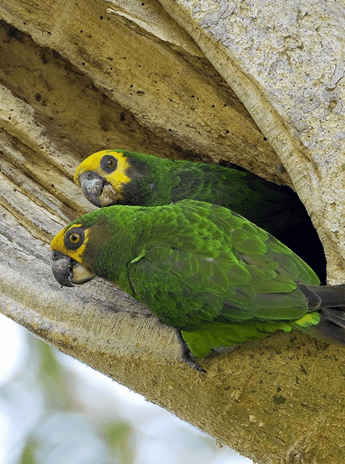The Yellow-fronted Parrot (Poicephalus flavifrons) is at risk from the loss of its Juniperus, Podocarpus and Acacia forests to illegal logging.
From 2002 to 2004 the World Parrot Trust supported a team in Ethiopia in preliminary and follow-up studies to gain more ecological and population information about the Yellow-faced Parrot. They aimed to confirm the occurrence of the species at known sites, look for new potential sites which looked favourable to the species and collect data on the basic biology (habitat, diet, behaviour and breeding).
The team addressed specific questions about the percentage of area occupied by the birds, their approximate decline over time, and other statistics. Although it is thought that the Yellow-fronted Parrot has a small distribution, more knowledge is required before their conservation status can be determined with any confidence, and realistic and effective conservation measures can be proposed.
Status: IUCN Least Concern / CITES Appendix II
Population: Unknown, stable.
Range: P.f. flavifrons: Highlands of N Ethiopia, and areas around Addis Ababa in C Ethiopia.
P.f. aurantiiceps: Known only from Masango area and Gilo River, SW Ethiopia.
Natural history: The Yellow-fronted Parrot (Poicephalus flavifrons) is found from 1800-3000 m (5904-9840 ft) in Juniperus and Podocarpus forests. They are also found in woodlands in cultivated plateau country and gallery forest in Acacia savanna. They consume buds, seeds, fruits and vegetables, some cultivated. Birds are generally found in pairs, small groups or flocks of up to 20, often with Black-winged Lovebirds (Agapornis taranta).

